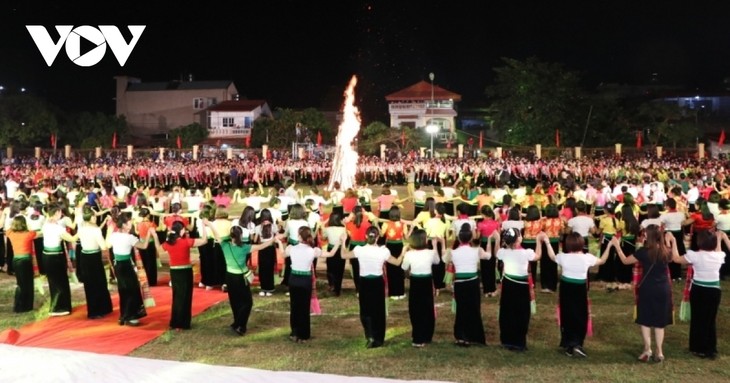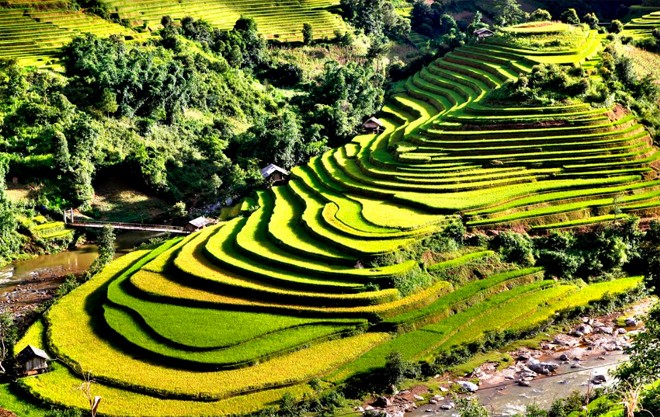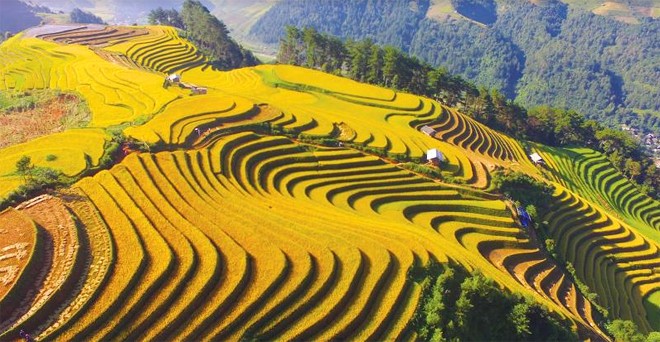 Thai girls dance Xoe with fans. Thai girls dance Xoe with fans. |
B: Our listeners sent us a lot of questions on Vietnam’s natural landscapes, historical sites, social issues, and scientific application.
A: Many of our listeners congratulate Vietnam for having the Xoe Thai dance listed as an Intangible Cultural Heritage of Humanity. It was recognized by UNESCO in December last year. Xoe Thai is a unique type of traditional dance that is associated with and plays a significant role in the daily life of Thai ethnic communities in the northwest of Vietnam, especially in the provinces of Lai Chau, Dien Bien, Son La and Yen Bai.
B: Yen Bai province will hold a ceremony to receive the UNESCO certificate for this art genre on Saturday with a performance of more than 2,022 people joining a Xoe dance of the Thai ethnic people.
 2,022 people joined a Xoe dance at the ceremony in yen Bai province to receive UNESCO's certificate to recognize Xoe Thai as an Intangible Cultural Heritage of Humanity. 2,022 people joined a Xoe dance at the ceremony in yen Bai province to receive UNESCO's certificate to recognize Xoe Thai as an Intangible Cultural Heritage of Humanity. |
A: On this occasion, Yen Bai will kick off the Muong Lo Culture and Tourism Week and the Mu Cang Chai Terraced Field Festival. Our Sunday Show this week will feature the Xoe dance, its cultural values in the life of Thai community.
B: Now we answer questions from Indonesian listener Fachri Fachiri about the Mu Cang Chai terraced rice field in Yen Bai province, its coverage, rice crop, and how to travel to Mu Cang Chai from Hanoi.
A: In April and May people fetch water into the fields to prepare soil for a new crop. The surface of terraced fields shines like many mirrors reflecting the contrast of the reddish brown of soil, the deep blue of the sky, and the green of surrounding forests.
B: In June and July the greenness of fully-grown paddy rice on terraced fields and forests spread from the foot to the top of mountains.
A: At the end of autumn in September and October, ripen rice paint all terraced fields with bright gold which looks like golden silk scarves folding around green mountain slopes.
 Mu Cang Chai terraced fields (baoyenbai.vn) Mu Cang Chai terraced fields (baoyenbai.vn) |
B: Terraced rice fields in Mu Cang Chai attach to distinctive cultural practices of Mong people which have been passed down for hundreds of years. Ho A Chua, whose family has a terraced field in Mu Cang Chai, talks about his farm work: The field is far from the water source. There are tens of families using the same water source so we have to dredge canals to get water to our field. We have one watchman at night and one during the day to get water.”
A: In the ripening rice season in September, Mu Cang Chai district don a "yellow coat" as paddy rice ripens. It’s one of the best time of the year to visit Mu Cang Chai.
B: Luong Thi Xuyen, Vice Chairman of Mu Cang Chai district’s People’s Committee, says that next week there will be a Paragliding Festival "Flying in the golden season" on Sunday, exploring Mu Cang Chai terraced fields by helicopter from now until October 5, a marathon Mu Cang Chai ULTRA TRAIL on Friday, the new rice celebration, Khen Mong Festival, and performances themed "Mu Cang Chai – Highland aspirations"
"We have organized teams to monitor security and food safety and hygiene as well as specific plans of adventurous sports such as paragliding and driving All Terrain Vehicle (ATV) vehicles on terraced fields. All activities will last until the middle of October," said Xuyen
A: As the COVID-19 pandemic is basically under control, tourism in Vietnam has rebounded strongly. We hope to welcome our dear listeners in Vietnam soon.
 Ripen rice fields in Mu Cang Chai, Yen Bai province (photo: baoyenbai.vn) Ripen rice fields in Mu Cang Chai, Yen Bai province (photo: baoyenbai.vn) |
B: Last week we received a letter from Fumito Hokamura of Japan. He said his hobby is to listen to VOV programs, especially Discovery Vietnam and Saturday Report.
A: Mr. Hokamura sends us postal letters on a weekly basis. We appreciate it very much because recently we have received more emails than letters.
B: Discovery Vietnam is one of our listeners’ most favorite features, which gives an in-depth look of Vietnam’s natural scenic spots to historical and cultural sites.
A: Loek Tong of Cambodia listened to a piece of news of the excavation of the Thang Long Imperial Citadel in Hanoi and he wants to know more about its history.
B: Thang Long, the capital of Đại Việt (Great Viet) developed prosperously from the 11th to the 15th centuries, under the reign of Ly – Tran – early Le. Due to many historical events, ancient Thang Long has only remained with memories of a magnificent and elegant capital city.
A: In 2002 and 2003, a large-scale archaeological excavation in the centre of Thang Long Royal Citadel revealed a wealth of monuments and relics which showed us the uninterrupted development of the history under dynasties in Thang Long – Hanoi.
B: The excavation of the Thang Long Royal Citadel, which is now at 18 Hoang Dieu Street, was the largest archaeological one in Vietnam to date.
A: Archeologists found different types of architectural monuments and relics with mixed date, overlaying on top of each other over the past 1300 years. The bottom layer is the architectural system of Early Thang Long time, also known as Dai La, evidently reflected through wooden columns, architectural foundation, sewers, and abundant artifacts.
B: Above the Dai La layer is architectural traces of Ly-Tran Dynasties, clearly shown in the architectural system with stone pillar and brick foundation, lotus rocks, brick yards, sewers, and great size and sophisticatedly decorated roof ornaments. Some positions have cultural traces of Dinh – Early Le Dynasties.
A: The top layer is vestiges of the Le Dynasty, including wooden-hammer bricks, well system, blue and yellow traditional tiles decorated with image of 5 claw dragons used to roof the Kings’ palaces and the royal porcelain dedicated to the kings. Some positions have traces of the Nguyen Dynasty in the 19th-20th centuries.
B: Thang Long Imperial Citadel opens to tourists during the day and the evening. The evening tour gives tourists a curious experience inside the ancient Forbidden City. Visitors also enjoy royal performances and art programs after exploring archaeological excavations.
A: Last in our program today, we thank many listeners for answering our questionnaires. VOV has sent questionnaires to ask listeners’ opinions on our programs and what you want to listen to in the near future. We appreciate your responses which will be used as important data for us to continue to innovate our radio programs. Thank you very much for your cooperation.
B: This week we continue to receive emails and congratulations for VOV’s founding anniversary on September 7th. We thank Fumito Hokamura of Japan, Jayanta Chakrabarty of India, Richard Lemke of Canada, Marsan Fritzen of Brazil, Anand Mohan Bain, the President of Pariwar Bandhu SWL Club, Didarul Iqbal, Founder of South Asia Radio Club Bangladesh, and many others.
A: That concludes today’s program. We welcome your feedback at: English Service, VOVWorld, the Voice of Vietnam, 45 Ba Trieu street, Hanoi, Vietnam. Or you can email us at: englishsection@vov.vn. You’re invited to visit us online at vovworld.vn, where you can hear both live and recorded programs.
B: Check out our VOV Media App, available on both the IOS and Android platforms, to hear our live broadcasts. We look forward to your feedback on the mobile version of vovworld.vn. Once again, thank you all for listening. Goodbye.